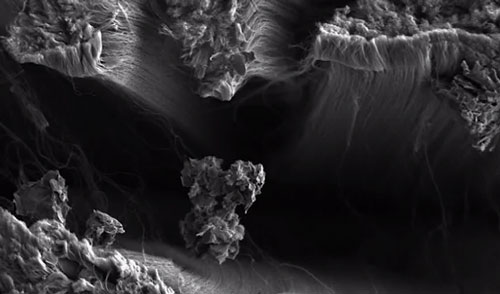| Posted: Jun 26, 2014 |
Nanomaterials Up Close: Forest of carbon nanotubes (w/video)
|
|
(Nanowerk News) This image shows a ‘forest’ of carbon nanotubes – thousands upon thousands of tiny rolls of carbon atoms, grown on a scrap of copper foil. James Dolan explains how easy it is to run across beautiful scenery such as this when attempting to fabricate new electronic devices for the first time.
|
 |
|
“It is easy to become distracted by the inherent beauty of the landscapes that can be found when investigating materials on the nanoscale.
|
|
What we are looking at here is a portion of a carpet or “forest” of carbon nanotubes, grown on a scrap of copper foil. Carbon nanotubes are exceptionally tiny rolls of carbon atoms, a few tens of nanometres across but potentially much longer. You can see a few individual tubes here and there in the image looking like errant hairs. However, the larger structures, similar to crested waves on a stormy sea, are many thousands upon thousands of individual tubes grown alongside one another that have attached together to form this “forest”.
|
|
|
|
We are growing them for use in various electronic devices, such as the electron source in X-ray guns. In fact, this sample is far too disordered to be useful for the intended measurement. These captivating structures have been formed by accident, perhaps from areas of the forest damaged by a careless scrape from a pair of tweezers.
|
|
Usually the nanotubes would form a complete and uniform forest, at which point they create one of the blackest materials to be found on earth.”
|
|
The image was taken using a scanning electron microscope in the Electrical Engineering Division of the Department of Engineering, University of Cambridge. Credit: Thanks to Professor Tim Wilkinson, Professor Ullrich Steiner and Professor Jeremy Baumberg for their ongoing support and to the NanoDTC for funding; EPSRC grant EP/G037221/1.
|
|
'Nanomaterials Up Close' is a special series linked to the 'Under the Microscope' collection of videos produced by Cambridge University that show glimpses of the natural and man-made world in stunning close-up.
|

